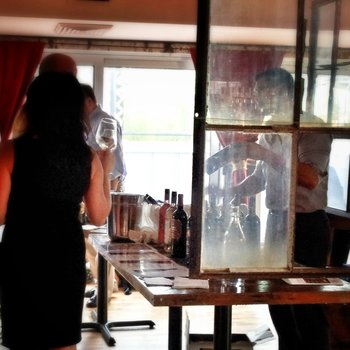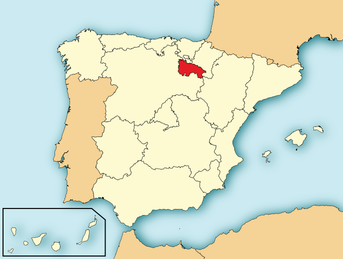| « Friday Foodpic: Sweet Mandy B's | Shana Tova from Real Urban Barbecue » |
Wine Mon Sep 15 2014
Rioja 101: A Tasting

The last wine at Table #5 was breathing in a glass decanter, one of those that looks like a genie bottle, but with a much wider and flatter bowl. The wine rep gave it a gentle swirl, sloshing the black-plum liquid before pouring a tasting.
"Ooooh," I said because I'm easily excited. I had only just begun the night's Rioja tasting, that famed Tempranillo-producing region in Spain, and the Maetierra Dominum QP Vintage 2006 was a great way to start. The wine was dark and rich and full. I really wanted something warm and hearty to eat with it.
"How long could you cellar this?" I asked.
He consulted another gentleman behind the table who explained, "Maybe 7-10 years. But it's not really necessary to cellar because you can drink the wine now."
It was true. The wine did not make my face shrivel up or suck all the moisture out of my mouth. Rioja is unique in that the winemakers do all they aging work for you by keeping their wines safely stored in a temperature-consistent cellar and releasing them only when they're ready to drink. Scads of other producers ship wines off to market even if they're too big and tannic and require time to smooth out the rough edges.
Rioja 101
 Located in north-central Spain, southeast of Bilbao, Rioja produces white, red, and rose (rosado). For reds, Garnacha (Grenache), Graciano, Mazuelo, Matura Tinta, and of course, Tempranillo, are cultivated. For whites, there's Viura, Malvasia, and Tempranillo Blanco. There were 13 total tables at the Rioja 101 tasting, hosted by Homestead on the Roof. Most tables had a minimum of four wines and with 58 total available, the breadth and diversity of the region was represented.
Located in north-central Spain, southeast of Bilbao, Rioja produces white, red, and rose (rosado). For reds, Garnacha (Grenache), Graciano, Mazuelo, Matura Tinta, and of course, Tempranillo, are cultivated. For whites, there's Viura, Malvasia, and Tempranillo Blanco. There were 13 total tables at the Rioja 101 tasting, hosted by Homestead on the Roof. Most tables had a minimum of four wines and with 58 total available, the breadth and diversity of the region was represented.
Spain, like several other wine-producing countries, quality-controls their wines and indicates this on the wine label. In Rioja, labels with a D.O.Ca. seal (Denominación de Origen Calificada) demonstrate that the wine has met these high-quality standards while also indicating how long the wine has aged. Thanks to my Rioja 101 cheat sheet, I knew what the specific classifications were.
- Cosecha: Wines in the first or second year or that fall out of the classifications below.
- Crianza: Wines at least in their third year and have spent a minimum of one year in casks for reds; six months for whites.
- Reserva: Best vintages with aging potential. Red wines are aged a minimum of three years with one in casks; whites are aged a minimum of two years with six months in casks.
- Gran Reserva: Wines from an "exceptional vintage," meaning not every year will be good enough to produce a Gran Reserva. These wines spend two years in oak and three in the bottle before being released; white wines are aged a minimum of four years with one year in casks.
Tasting
I stopped at eight of the 13 tables, tasting most of the wines offered at each. I started with the white and rosado and worked my way through the lighter, less-aged wines to the intense Gran Reservas to see, smell, and feel the differences in these levels and how wines evolve as they age. See how the younger Crianza wines were more red-berry in color, but the Gran Reservas were more black-plum. Feel how those Reservas and Gran Reservas had more weight on the palate. But there were also similarities: the wines had aromas of red or dark fruit, some with more spice and earthiness than others, but there were no fruit bombs here and none that were overly tannic.
Some people go nuts for those Gran Reservas: they're luxurious and substantial. And the most expensive, but still affordable compared to similarly high-quality wines from France, especially since you can drink the Gran Reserva the night you buy it. These are definitely not porch-pounding wines; these are melt-into-your-couch wines.
Generally, I gravitate toward those porch pounders, those light-to-medium bodied wines because they're great for a relaxing post-work drink, and they're more food-friendly. They're not so intense that they overwhelm the meal, and I don't eat much of those heavier foods, like beef, that would stand-up to big wines. One of my favorites from the tasting was a Crianza, the Bodegas Sierra Cantabria Crianza 2010. I know this now only because I made a special note on my tasting sheet: "smooth as hell."
This is how Rioja got me as a fan: they produce a myriad of fantastic, easy-drinking wines that are enjoyable on their own or with food. One wine rep used a new favorite expression when describing the Bodegas Muga Rosado: "F-squared for friends and fish." Yet, Rioja also produces grand wines for those that like that heavier richness. Either way, they're not going to break the bank.








